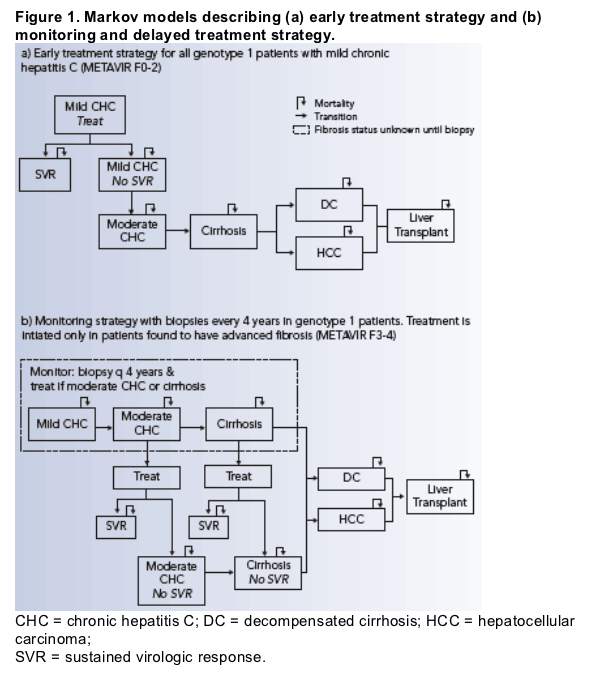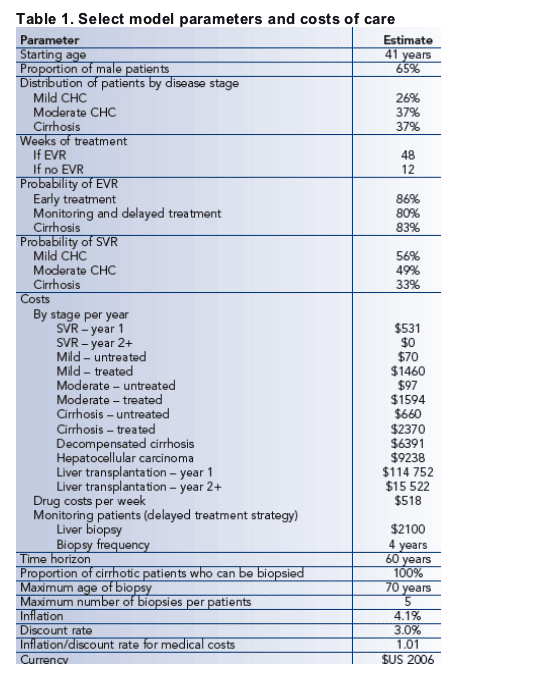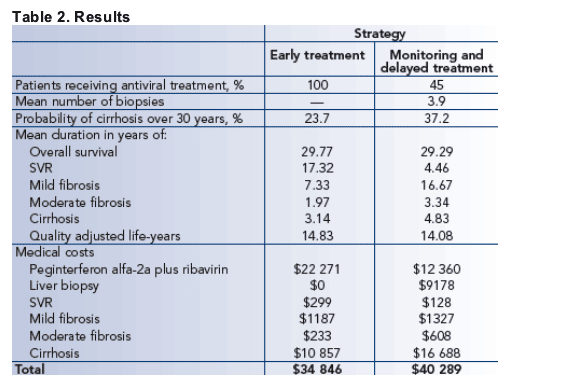 |
 |
 |
| |
Cost-effectiveness, Survival, and Prevention of Cirrhosis with Early Treatment of Chronic Hepatitis C with Peginterferon Alfa-2a (40KD) plus Ribavirin before Progression to Advanced Liver Disease
|
| |
| |
Reported by Jules Levin
Presented at Digestive Disease Week (DDW) 2007, May 19-24, 2007, Washington DC, USA.
This research was funded by Roche, Basel, Switzerland.
J. Hornberger,1,2 P. Pockros,3 E. Verhulst,1 T-C. Chu,4 K.K. Patel,4 M.L. Shiffman5
1The SPHERE Institute, Acumen, LLC, Burlingame, CA, USA; 2Dept of Medicine, Stanford University School of Medicine, Stanford, CA, USA; 3Scripps Clinic, La Jolla, CA, USA; 4Roche, Nutley, NJ, USA; 5Hepatology Section, Virginia Commonwealth University Medical Center, Richmond, VA, USA
"....Early treatment strategy for all genotype 1 patients with mild chronic
hepatitis C (METAVIR F0-2)....improved SVR rate, 56% in patients with mild fibrosis vs 43% in patients with advanced fibrosis.... reduced the 30-year risk of cirrhosis by 13.5% (23.7% with early treatment vs. 37.2% with monitoring and delayed treatment....increased mean survival adjusted for quality of life by 0.75 years.....early treatment strategy was associated with cost savings of $5443....Reducing patient age from 41 to 25 years increased cost-savings from $5433 to $5824. Treatment of mild CHC remained cost saving at ages <57 years...."
Authors concluded:
Early treatment with peginterferon alfa-2a (40KD) (PEGASYS) plus RBV (COPEGUS) in patients with HCV genotype 1 infection is more effective than delaying treatment until fibrosis progresses to advanced stages.
An early treatment policy is cost saving. According to our model, this strategy would reduce the risk of cirrhosis, increase life expectancy, and cost less than a policy of monitoring and delayed treatment.
INTRODUCTION
Current guidelines recommend a pegylated interferon plus ribavirin (RBV) as the treatment of choice for chronic hepatitis C (CHC).[1, 2] The rate of sustained virologic response (SVR) achieved with such therapy is >80% in patients with HCV genotypes 2 or 3 and >50% in patients with genotype 1 infection.[3-5]
Patients with more advanced liver disease, as indicated by higher fibrosis stage on liver biopsy, are less likely to achieve an SVR after antiviral therapy.[3-5] This finding suggests that the optimal treatment strategy for CHC would be treatment of patients with early stage fibrosis.[6] An early treatment strategy would be expected to increase the individual probability of a cure and decrease the incidence of decompensated cirrhosis and hepatocellular carcinoma, the long-term complications of CHC. However, the cost implications of an early treatment strategy are unknown.
We determined the costs and benefits associated with early treatment of patients with mild CHC by using a Markov model and pooled data from two randomized trials of peginterferon alfa-2a (40KD) (PEGASYS®) plus RBV (COPEGUS®).[3, 4]
METHODS
Clinical data used in this analysis were pooled from two large phase III clinical trials.[3,4] Data from 328 treatment naive patients with HCV genotype 1 infection, elevated ALT levels and compensated liver disease were included.[6] All patients had a baseline liver biopsy evaluated for fibrosis by a local pathologist.
Patients were grouped according to the baseline fibrosis score as having mild fibrosis (METAVIR F0-2, no fibrosis or portal fibrosis) or advanced fibrosis (METAVIR F3-4, incomplete septa or cirrhosis).
The SVR rate was 56% in patients with mild fibrosis and 43% in patients with advanced fibrosis.[6]
In the model the costs and benefits associated with treatment with peginterferon alfa-2a (40KD) 180 _g/week plus RBV 1200 mg/day (the high end of the recommended range) were compared with the alternative of monitoring patients with serial liver biopsies repeated at 4-year intervals and initiating treatment only if liver disease progressed to an advanced stage.
The two competing strategies are illustrated in Figure 1. Patients with SVR after treatment are assumed to have the same risk of death as a person without CHC. Patients without an SVR after treatment are assumed to have the same risk of disease progression as those with untreated CHC.

Transition probabilities used in the model were based on the model developed by Salomon et al.[7,8] and adapted by Hornberger et al.[9,10] Parameter estimates are presented in Table 1. Fibrosis progression rates, estimates of annual mortality rates and quality of life utilities were summarized from published sources.[7, 8, 11-15]
Costs considered in the model were those associated with drugs, liver biopsy, outpatient medical care and inpatient care (for cirrhosis, liver cancer and liver transplantation).
The base case was a male aged 41 years with HCV genotype 1 infection and mild fibrosis.
The analysis was conducted from a societal perspective.
One-way sensitivity analyses were conducted to assess alternative values for age, gender, SVR rates, transition probabilities, costs, discount rates and inflation rates.

RESULTS
The model showed that early treatment of patients with mild disease with peginterferon alfa-2a (40KD) plus RBV reduced the 30-year risk of cirrhosis by 13.5% (23.7% with early treatment vs. 37.2% with monitoring and delayed treatment; Table 2).
The early treatment strategy increased mean overall survival by 0.48 years and increased mean survival adjusted for quality of life by 0.75 years.

With monitoring and delayed treatment, 45% of patients received combination therapy at some point, resulting in a $9911 reduction in drug costs as compared with the early treatment strategy. However, this was offset by the cost of monitoring and serial liver biopsies ($9178) and treatment for progressive liver disease and complications of cirrhosis ($6346).
On balance, the early treatment strategy was associated with cost savings of $5443 as compared with the monitoring and delayed treatment strategy over the lifetime of each patient (Figure 2).
One-way sensitivity analysis showed that age and social discount rate were the most influential parameters in the model. Reducing patient age from 41 to 25 years increased cost-savings from $5433 to $5824. Treatment of mild CHC remained cost saving at ages <57 years.

REFERENCES
1. Dienstag JL, McHutchison JG. American Gastroenterological Association medical position statement on the management of hepatitis C. Gastroenterology 2006; 130(1): 225-30.
2. Strader DB, Wright T, Thomas DL, Seeff LB. Diagnosis, management, and treatment of hepatitis C. Hepatology 2004; 39(4): 1147-71.
3. Fried MW, Shiffman ML, Reddy KR, et al. Peginterferon alfa-2a plus ribavirin for chronic hepatitis C virus infection. N Engl J Med 2002; 347(13): 975-82.
4. Hadziyannis SJ, Sette H, Jr., Morgan TR, et al. Peginterferon-alpha2a and ribavirin combination therapy in chronic hepatitis C: a randomized study of treatment duration and ribavirin dose. Ann Intern Med 2004; 140(5): 346-55.
5. Manns MP, McHutchison JG, Gordon SC, et al. Peginterferon alfa-2b plus ribavirin compared with interferon alfa-2b plus ribavirin for initial treatment of chronic hepatitis C: a randomised trial. Lancet 2001; 358(9286): 958-65.
6. Shiffman ML, Fried M, Marcellin P, Govindarajan S, Lopez-Talavera J-C, Pockros P. Peginterferon alfa-2a/ribavirin treatment in patients with chronic HCV
genotype 1: efficacy is improved in patients with early stages of fibrosis [abstract S1568]. Gastroenterology 2005; 128 (Suppl).
7. Salomon JA, Weinstein MC, Hammitt JK, Goldie SJ. Empirically calibrated model of hepatitis C virus infection in the United States. Am J Epidemiol 2002; 156(8): 761-73.
8. Salomon JA, Weinstein MC, Hammitt JK, Goldie SJ. Cost-effectiveness of treatment for chronic hepatitis C infection in an evolving patient population. JAMA 2003; 290(2): 228-37.
9. Hornberger J, Farci P, Prati D, Zeuzem S, Green J, Patel KK. The economics of treating chronic hepatitis C patients with peginterferon alpha-2a (40 kDa) plus
ribavirin presenting with persistently normal aminotransferase. J Viral Hepat
2006; 13(6): 377-86.
10. Hornberger J, Torriani FJ, Dieterich DT, et al. Cost-effectiveness of peginterferon alfa-2a (40kDa) plus ribavirin in patients with HIV and hepatitis C virus co-infection. J Clin Virol 2006; 36(4): 283-91.
11. Anon. Surveillance and Epidemiology End Results Program SEER*STAT public-use files. Bethesda, MD. National Cancer Institute; 2003.
12. Forman LM, Lewis JD, Berlin JA, Feldman HI, Lucey MR. The association
between hepatitis C infection and survival after orthotopic liver transplantation.
Gastroenterology 2002; 122(4): 889-96.
13. Hickman M, Carnwath Z, Madden P, et al. Drug-related mortality and fatal overdose risk: pilot cohort study of heroin users recruited from specialist drug treatment sites in London. J Urban Health 2003; 80(2): 274-87.
14. Vlahov D, Wang CL, Galai N, et al. Mortality risk among new onset injection
drug users. Addiction 2004; 99(8): 946-54.
15. Thein HH, Krahn M, Kaldor JM, Dore GJ. Estimation of utilities for chronic hepatitis C from SF-36 scores. Am J Gastroenterol 2005; 100(3): 643-51.
|
| |
|
 |
 |
|
|